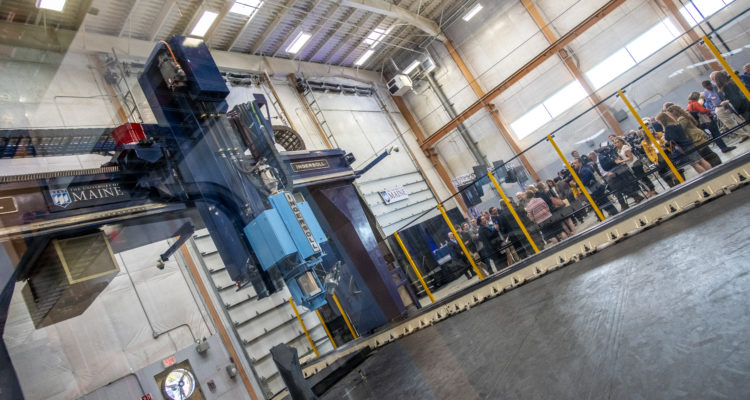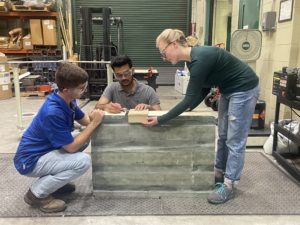Universities play a pivotal role in research and development. In 2020, academic institutions spent $86.4 billion on R&D, according to the National Center for Science and Engineering Statistics. Some of those dollars – and the resulting projects – impacted materials, technologies, applications and more in the composites industry.
This year’s annual feature article on university research highlights four composite-related projects, ranging from fundamental science examining defects in thermoset materials to envelope retrofits making homes more energy efficient.
Residential Retrofits Lead to Energy Efficiency
Project: Composite Panels for Envelope Retrofits
School: The University of Tennessee, Knoxville
Location: Knoxville, Tenn.
Principal Investigator: Uday Vaidya
The residential sector accounts for approximately 21% of total U.S. energy consumption, and the average household is responsible for releasing 70% more CO2 emissions than the average car, according to the U.S. Department of Energy. Researchers at the University of Tennessee, Knoxville (UTK) have developed a solution to help combat the problem.
“There is a strong need for dependable, cost-effective building envelope retrofit solutions in order to meet decarbonization targets,” says Uday Vaidya, Governor’s Chair in Advanced Composite Manufacturing at UTK-Oak Ridge National Laboratory. “We created a modular, overclad composite panel system that provides an innovative way to modernize buildings – and make them more energy efficient – without a lot of changes to the base structure.”
During the first phase of the project, UTK collaborated with Oak Ridge National Laboratory (ORNL) to develop the material solution. The team designed sandwich construction panels made from fiberglass, epoxy resin, polyurethane foam and pultruded profiles. The panels, which are five to six inches thick and measure either 4 x 12 feet or 5 x 12 feet, are fabricated using vacuum infusion and braiding techniques.
“They are very lightweight – less than four pounds per square foot – so they can be easily carried by two people and installed with small equipment,” says Vaidya. “The panels provide minimal disruption to existing structures, which is key. They are designed with all the necessary connections to homes and gutters for drainage.” The panels can also be customized to feature the desired finish, or wall cladding, such as siding, can be placed on top after installation.
UTK teamed up with the Building Technologies Research and Integration Center at ORNL for the second phase to identify homes for a demonstration project. Together, they selected 13 homes in the Knoxville area, each approximately 2,500 square feet, to receive a full-house envelope retrofit.
“Collectively, this provides not only a very strong demonstration, but actual usage in a commercial application,” says Vaidya. “Any future work will build off of this.”
UTK and ORNL are now collaborating with several organizations on materials, design, manufacturing and installation of the panel systems, which they anticipated beginning at the end of September. Partners include IACMI – The Composites Institute’s Scale-Up Research Facility, DB Technologies, Compsys Inc. and Olin. While certain composite materials will be used for the demonstrator panel system, Vaidya says the design allows for flexibility.
“Ultimately, we are looking for low-cost, high-performance solutions. Economics will be the driver,” he says. “Building construction is continuously innovating, and our approach uses advanced materials in a cost-effective way.”
From left, undergraduate researcher John Klepzig and graduate student Vinit Chaudhary work with Alexia Rice, a staff member at UTK, on a composite panel.
Photo Credit: University of Tennessee, Knoxville
Cracking a Critical Curing Problem
Project: Process Modeling of Composite Microcracking
School: UMass Lowell
Location: Lowell, Mass.
Principal Investigator: Marianna Maiaru
Marianna Maiaru began modeling aerospace thermoset composites as a graduate student at Turin Polytechnic Institute in Italy. Working in collaboration with the University of Michigan, she developed computationally efficient multiscale approaches for progressive failure analysis of fiber-reinforced polymer composite structures. Since then, her work with industry and government agencies has further illuminated major technological challenges in composite manufacturing.
Earlier this year, Maiaru received the CAREER Award, an early-career development award from the National Science Foundation that included more than $568,000 in funding. She will use the five-year grant to perform computational modeling to predict damage and to validate her process modeling techniques and predict curing-induced microcracking.
“Extensive microcracking can compromise the strength of the thermoset and contribute to the structure’s subsequent failure,” says Maiaru, an associate professor in mechanical engineering at the University of Massachusetts Lowell. “The failure is very difficult to predict, so when manufacturers take the component out of the oven and see it’s fractured, they typically have to dispose of the part.”
Maiaru’s team will first seek to understand why microcracking occurs during curing, then develop software to predict the microcracking process. “We will subsequently optimize the cure cycle to prevent microcracking,” she says.
One key to predicting microcracking is understanding material behavior during curing. Maiaru will test various thermoset materials used throughout industry, including resins that are more prone to microcracking.
“One of my hypotheses is that resin brittleness influences microcracking,” she says. “Depending on processing conditions, if the resin is a little more brittle in some parts of the cure cycle, then it’s more prone to crack.”
Gaining a clearer understanding of material behavior has industrial implications.
“Microcracking occurs in all different kinds of manufacturing environments, particularly those that include large structures, such as aerospace and wind energy,” says Maiaru. “Companies would be interested in being able to predict if cracking occurs before the material enters production. This would help them save time and money and make higher quality parts.”
While Maiaru’s research is a fundamental science project, she hopes her work ultimately leads to the development of crack-free thermoset materials.
“Our ability to manufacture the next-generation of high-performance, lightweight, complex structures depends upon fabricating damage-free composites with enhanced mechanical properties,” she says.
Marianna Maiaru, shown at the laptop computer, leads a team of researchers at the University of Massachusetts Lowell who are developing software to predict microcracking in composites.
Photo Credit: Umass Lowell
Giving Wings to 4D Printing
Project: 4D Composite Printing
School: Concordia University
Location: Montreal
Principal Investigator: Suong Hoa




